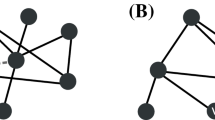Abstract
Question-Answering Bulletin Boards (QABB), such as Yahoo! Answers and Windows Live QnA, are gaining popularity recently. Questions are submitted on QABB and let somebody in the internet answer them. Communications on QABB connect users, and the overall connections can be regarded as a social network. If the evolution of social networks can be predicted, it is quite useful for encouraging communications among users. Link prediction on QABB can be used for recommendation to potential answerers.
Previous approaches for link prediction based on structural properties do not take weights of links into account. This paper describes an improved method for predicting links based on weighted proximity measures of social networks. The method is based on an assumption that proximities between nodes can be estimated better by using both graph proximity measures and the weights of existing links in a social network. In order to show the effectiveness of our method, the data of Yahoo! Chiebukuro (Japanese Yahoo! Answers) are used for our experiments. The results show that our method outperforms previous approaches, especially when target social networks are sufficiently dense.
Similar content being viewed by others
References
Adamic, L. A., Adar, E., “Friends and Neighbors on the Web,” Social Networks, 25(3),pp.211-230, 2003.
Barabasi, A. L., Linked - The New Science of Networks, Perseus, 2002.
Getoor, L., Diehl, C. P., “Link Mining: A Survey,” SIGKDD Explorations, 7(2), pp.3-12, 2005.
Hasan, M. A., Chaoji, V., Salem, S., Zaki, M., “Link Prediction using Supervised Learning,” in Workshop on Link Discovery; Issues, Approaches and Applications (LinkKDD-2005), 2005.
Huang, Z., “Link Prediction Based on Graph Topology: The Predictive Value of the Generalized Clustering Coefficient,” in Workshop on Link Analysis; Dynamics and Static of Large Networks, (LinkKDD-2006), 2006.
Kashima, H., Abe, N., “A Parameterized Probabilistic Model of Network Evolution for Supervised Link Prediction,” in Proc. of the Sixth IEEE Int. Conf. on Data Mining(ICDM’06), 2006.
Kautz, H., Selman, B., Shah, M., “The Hidden Web,” AI Magazine, 18(2), pp. 27-36, 1997.
Liben-Nowell, D., Kleinberg, J., “The Link Prediction Problem for Social Networks,” in Proc. of the Twelfth Int. Conf. on Information and Knowledge Management (CIKM), pp.556-559, 2003.
Newman, M. E., “Clustering and Preferential Attachment in Growing Networks,” Physical Review Letters E, 64 (025102), 2001.
O’Madadhaim, J., Hutchins, J., Smyth, P., “Prediction and ranking algorithms for event-based network data,” SIGKDD Explorations, 7(2), pp.23-30, 2005
Popescul, A., Ungar, L. H., “Statistical relational learning for link prediction,” in IJCAI Workshop on Learning Statistical Models from Relational Data, 2003.
Sarukkai, R. R., “Link Prediction and Path Analysis Using Markov Chains,” in Proc. of the Ninth Int. World Wide Web Conf. (WWW9), 2000.
Taskar, B., Wong, M.-F., Abbeel, P., Koller, D., “Link Prediction in Relational Data,” in Proc. of Neural Information Processing Systems Conf. (NIPS), 2003.
Author information
Authors and Affiliations
Corresponding author
About this article
Cite this article
Murata, T., Moriyasu, S. Link Prediction based on Structural Properties of Online Social Networks. New Gener. Comput. 26, 245–257 (2008). https://doi.org/10.1007/s00354-008-0043-y
Received:
Revised:
Published:
Issue Date:
DOI: https://doi.org/10.1007/s00354-008-0043-y




